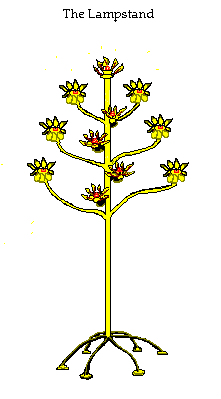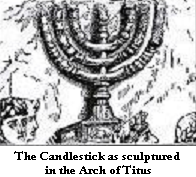Contents Page
Joseph Theory Addendum Index
Verses quoted are from King James' translation
All links open in a new window

The Joseph Theory
Addendum
The Lampstand


These are the instructions for the lampstand.
The descriptions used... are those of a tree.
Exodus 25:31 --
"And you shall make a candlestick of pure gold; of beaten work shall
the candlestick be made. His shaft, and his branches, his bowls, his
knops, and his flowers, shall be of the same.
And six branches shall come out of the sides of it; three branches
of the candlestick out of the one side, and three branches of the
candlestick out of the other side.
Three bowls made like unto almonds,with a knop and a flower
in one branch, and three bowls made like almonds in the other
branch, with a knop and a flower; so in the six branches that
come out of the candlestick.
And in the candlestick shall be four bowls made like unto almonds,
with their knops and their flowers. And there shall be a knop under
two branches of the same, and a knop under two branches of the same,
and a knop under two branches of the same, according to the six
branches that proceed out of the candlestick. Their knops and their
branches shall be of the same; all of it shall be one beaten work of
pure gold.
And you shall make the seven lamps thereof, and they shall light the
lamps thereof, that they may give light over against it.
And the tongs thereof, and the snuff dishes thereof, shall be of pure
gold. Of a talent of pure gold shall he make it, with all these vessels.
And look that you make them after their pattern, which was showed
you on the mount."
In Exodus 26:35
"And you shall set the table without the vail, and the candlestick over
against the table on the side of the tabernacle toward the south, and
you shall put the table on the north side."

The Lampstand
The first requirement that helps to define the appearance of the
lampstand is that the total weight... of it and the implements...
is to be a talent of gold. This is approx. 108 lbs. of gold.
The second... is that it is free-standing. The table in the
instructions for the Tent of God is set on the north side of the tent,
and the lampstand is set on the south. There is no mention of a
table for the lamp itself.
The third... there are almond blossoms and knops (or seed pods)
that serve as the lamps on the lampstand. This works beautifully.
Almond blossoms... from the almond tree... are the shape of a
petunia somewhat, with 5 petals. On each lamp, the knop would
be the bowl of oil... the blossom would cover the bowl and hold the
wick (the stamin)... and golden tree leaves would reflect light
into the tent.
In Hebrew, Luz means "almond." The name of this
tree means "to wake or watch" because it is the first to wake from
the sleep of winter... the first to blossom in spring. The almond tree
is a genus of the peach. There is another ancient term called "almond."
In the language of lapidaries, or gem cutters... "almonds" are pieces of
rock crystal that are used in adorning branch candlesticks.
The fourth thing to note is... there is a main shaft to the lamp, with
six branches coming forth from it. There are also to be four bowls on
the main shaft... without the branches that are mentioned for the first
six lamps. The most logical place for these bowls (and per the stated
instructions) is between the 6 branches. These are to be lamps, as well,
with knops and flowers.
The number "seven" that is mentioned does not connect to anything
that is described in the instructions, unless it refers to the branches
and a lamp at the top of the shaft of the lampstand. And there is no
specific meaning to "seven" in the design of the tent of God.
There is however, meaning to "eleven" lamps. Aaron, was
the priest and his sons. The Levite tribe was the tribe of service, and
were separate from the whole of the tribes of Israel. And so, eleven
tribes being served by one tribe... expressed in the eleven lamps
being attended to by Aaron and his sons. This makes ultimate sense...
moreso than the named "seven." SEVEN may well mean the number
of leaves surrounding each light, which would reflect the light from
the candle into the room.
Exodus 28:43 -- "And [the priests clothes] shall be upon Aaron,
and upon his sons, when they come in unto the tabernacle of the
congregation, or when they come near unto the altar to minister
in the holy place; that they bear not iniquity, and die: it shall
be a statute for ever unto him and his seed after him."
Numbers 1:49 -- "Only thou shalt not number the tribe of Levi,
neither take the sum of them among the children of Israel: But
thou shalt appoint the Levites over the tabernacle of testimony,
and over all the vessels thereof, and over all things that belong to it: they shall bear the tabernacle, and all the vessels thereof; and
they shall minister unto it, and shall encamp round about the
tabernacle."
All these instructions give clues to the shape of this lampstand.
The master who worked with the gold (which would need to be
reinforced with another metal for strength) would be limited in the
design of the lampstand to what shape could evolve from this amount
of metal. He would likely begin with the needs of the implements
and their design... and then incorporate what metal was remaining
into the making of the lamp.
If one wanted to ensure a balanced appearance to a free-standing
oil-burning lampstand, it may well take on the shape of a tree, and
with so many candles burning on it... it would give the impression
of a burning bush.

The Arch of Titus, erected in A.D. 91 to commemorate the conquests
of Titus in Judea... has a rendering of the candlestick taken from
Jerusalem. Some believe that this is the best source for knowing what
this candlestick and its implements looked like. This sculpture looks
exactly like the menorah used today in Jewish traditions, with the
exception being that it had only seven branches, while today there
are nine.
In "Halley's Bible Handbook" under Exodus 35-40, it reads,
"[The Candlestick]... Thought to have been 5 ft. high and
3 1/2 ft. across the top."
From: Halley's Bible Handbook





